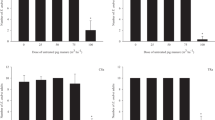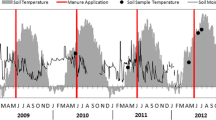Abstract
This study explored whether biofumigation with rapeseed can reduce swine parasite eggs in pasture soil. Pastures were subjected to four treatments: rapeseed or Ladino clover pastures, each with or without biofumigation (i.e., mechanical incorporation of plant residues into the soil). Each pasture was split into four paddocks and eight to nine pigs were given access to each paddock for 1 week. Fecal samples (n = 66) were collected from each pig before grazing for analysis of Ascaris suum, Trichuris suis, and Oesophagostomum spp. egg counts. Soil samples (n = 480) were collected from each paddock before grazing, immediately after pigs were removed from paddocks, and weekly thereafter for 3 weeks for analysis of Ascaris suum and Trichuris suis egg counts. Pasture treatment did not affect egg counts of either parasite species in the soil. Eggs of A. suum and T. suis in pasture soil were reduced (both P < 0.05) 2 weeks after pigs were removed, compared to before grazing and immediately after pigs were removed. Results suggest that biofumigation was not effective in reducing swine parasite eggs in organic pasture soil under conditions of the current study, and parasite contamination was reduced 2 weeks after pigs were removed from pastures regardless of biofumigation.

Similar content being viewed by others
Data availability
The raw data supporting the conclusions of this article will be made available by the authors upon request, without undue reservation.
References
Alabouvette C, Olivain C, Steinberg C (2006) Biological control of plant diseases: the European situation. Eur J Plant Pathol 114:329–341 https://doi.org/10.1007/s10658-005-0233-0
Anderson RC (2000) Nematode parasites of vertebrates. Their development and transmission, 2nd edn. CABI Publishing, Wallingford, p 276
Angus JF, Gardner PA, Kirkegaard JA, Desmarchelier JM (1994) Biofumigation: isothiocyanates released from Brassica roots inhibit growth of the take-all fungus. Plant Soil 162:107–112
Bello A, Lopez-Perez JA, Garcia-Alvarez A, Sanz R, Lacasa A (2004) Biofumigation and nematode control in the Mediterranean region. In: Cook RC, Hunt D (eds) Proceedings of the 4th International Congress of nematology, June 8–13, 2002, Tenerife, Spain, Nematology monographs and perspectives vol 2: 133–149. Brill, Leiden and Boston
Boes J, Nansen P, Stephenson LS (1997) False-positive Ascaris suum egg counts in pigs. Int J Parasitol 27(7):833–838
Carstensen L, Vaarst M, Roepstorff A (2002) Helminth infections in Danish organic swine herds. Vet Parasitol 106:253–264
Cole RA (1976) Isothiocyanates, nitriles and thiocyanates as products of autolysis of glucosinolates in Cruficerae. Phytochemistry 15:759–762
Gardner J, Morra MJ, Eberlein CV, Brown PD, Borek V (1999) Allelochemical released in soil following incorporation of rapeseed (Brassica napus) green manures. J Agric Food Chem 47:3837–3842
Hernandez AD, Li YZ, Carr R, Major S (2023) Intestinal roundworm infection in organic and alternative swine farms in the USA. Vet Parasitol 314:109856. https://doi.org/10.1016/j.vetpar.2022.109856
Johnson G (2009) Fumigation alternatives—biofumigants. Weekly Crop Update from University of Delaware Cooperative Extension. https://sites.udel.edu/weeklycropupdate/?p=837. Accessed 30 Apr 2023
Katakam KK, Thamsborg SM, Dalsgaard A, Kyvsgaard NC, Majer H (2016) Environmental contamination and transmission of Ascaris suum in Danish organic pig farms. Parasites Vectors 9(80):1–12. https://doi.org/10.1186/s1307-016-1349-0
Kirkegaard JA, Sarwar M (1998) Biofumigating potential of brassicas. Plant Soil 201:71–89
Kondra ZP, Downey RK (1970) Glucosinolate content of rapeseed (Brassica napus L. and B. campestris L.) meal as influenced by pod position on the plant. https://doi.org/10.2135/cropsci1970.0011183X001000010021x
Larsen MN, Roepstorff A (1999) Seasonal variation in development and survival of Ascaris suum and Trichuris suis eggs on pastures. Parasitology 119:209–220
Li YZ, Hernandez AD, Major S, Carr R (2022) Occurrence of intestinal parasites and its impacts on growth performance and carcass traits of pigs raised under near-organic conditions. Front Vet Sci 9:911561. https://doi.org/10.3389/fvets.2022.911561
Lindgren K, Bochicchio D, Hegelund L, Leeb C, Mejer H, Roepstorff A, Sandrum A (2014) Animal health and walfare in production systems for organic fattening pigs. Org Agric 4:135–147
Lindgren K, Cunnarsson S, Hoglund J, Lindahl C, Roepstorff A (2020) Nematode parasites eggs in pasture soils and pigs on organic farms in Sweden. Org Agric 10:289–300. https://doi.org/10.1007/s13165-019-00273-3
Morra MJ, Kirkegaard JA (2002) Isothiocyanate release from soil-incorporated Brassica tissues. Soil Biol Biochem 34:1683–1690
Nansen P, Roepstorff A (1999) Parasitic helminths of the pig: factors influencing transmission and infection levels. Int J Parasitol 29:877–891
NOP (National Organic Program) (2020) Agricultural Marketing Service USDA. Available at: Section A. Standards | Agricultural Marketing Service (usda.gov)
Ploeg A (2008) Biofumigation to manage plant-parasitic nematodes. Integrated mnagement and biocontrol of vegetable and grain crops nematodes. In: Ciancio A, Mukerji KG (eds) Vol. 2: 239–248. 2008 Springer ISBN 978-1-4020-6062-5. Available at: https://link.springer.com/chapter/10.1007/978-1-4020-6063-2_12
Roepstorff A, Nansen P (1998) Epidemiology, deagnosis and control of helminth parasites of swine. FAO Animal Health Manual, FAO of the United Nations, Rome, Italy pp 171
Roepstorff A, Murrell KD, Boes J, Petkevičius S (2001) Ecological influences on transmission rates of Ascaris suum to pigs on pastures. Vet Parasitol 101:143–153
Roepstorff A, Mejer H, Nejsum P, Thamsborg SM (2011) Helminth parasites in pigs: new challenges in pig production and current research highlights. Vet Parasitol 180:72–81
Funding
This work was supported by the Organic Transition Program (Award#: 2018–51106-28772) from the USDA National Institute of Food and Agriculture.
Author information
Authors and Affiliations
Contributions
All authors contributed to the study hypothesis and design. Field work and lab work were conducted by Sara Major, Rick Carr, and Alexander Hernandez. Data analysis was performed by Yuzhi Li. The first draft of the manuscript was written by Yuzhi Li, and all authors edited and commented on previous versions of the manuscript. All authors read and approved the submitted version.
Corresponding author
Ethics declarations
Ethics approval
The protocol for the animal study was reviewed and approved by the University of Minnesota Institutional Animal Care and Use Committee (IACUC#: 2106-39200A).
Competing interests
The authors declare no competing interests.
Additional information
Publisher's Note
Springer Nature remains neutral with regard to jurisdictional claims in published maps and institutional affiliations.
Rights and permissions
Springer Nature or its licensor (e.g. a society or other partner) holds exclusive rights to this article under a publishing agreement with the author(s) or other rightsholder(s); author self-archiving of the accepted manuscript version of this article is solely governed by the terms of such publishing agreement and applicable law.
About this article
Cite this article
Li, Y., Major, S., Carr, R. et al. Impact of biofumigation on reducing swine parasite contamination on organic pastures. Org. Agr. 14, 85–94 (2024). https://doi.org/10.1007/s13165-024-00456-7
Received:
Accepted:
Published:
Issue Date:
DOI: https://doi.org/10.1007/s13165-024-00456-7




